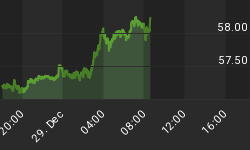The employment report released last Friday gave economists reason to forecast that the Fed will stop after one more hike. After the ADP report caused economists to raise forecasts for the number of jobs created in June, the Labor Department reported that only 121,000 workers were added to nonfarm payrolls. Economists did express concern over the higher than expected increase in hourly earnings. Average hourly earnings increased 0.5% in June, significantly higher than the 0.1% increase forecasted. Compared to last year, hourly earnings were 3.9% higher. This is the largest increase since June 2001. It was also noteworthy, that similar to the previous months, the household data showed a larger increase in payrolls. According to the household survey, 387.000 workers joined the workforce. The employment ratio ticked up to 63.1%, the highest since October 2001. Another interesting aspect from the household survey was the average duration of unemployment dropped to 16.2 weeks, the lowest since April 2002. Needless to say, while economists were quick to point out that the employment report is evidence that the economy is slowing, the data remains mixed enough that when coupled with continued inflation pressure, the Federal Reserve will likely have to be more diligent than most economist currently expect.
Higher interest rates and higher energy prices are starting to pressure consumer spending. Most of the weakness continues to be focused to lower income consumers, but there is mounting evidence that overall spending is starting to weaken. According to the ICSC, chain store sales increased only 2.6% in June. This was below the 3.8% average increase this year and the 3% to 3.5% increase that was forecasted. Partially explaining the weaker growth was that retailers faced the toughest comp of the year. Last June, chain store sales increased a robust 5.2%. With lower income consumer feeling more pinched by higher energy prices, it should not be surprising that general merchandise retailers are lagging department stores. General merchandiser stores had same store sales growth of only 2.4% compared to a 3.5% increase among department stores. Wal-Mart reported that its same store sales were up only 1.2% and was among the weakest of all retailers. Traffic was negative, while the average ticket rose. Several analysts speculate that consumers are "bundling" shopping trips due to the higher cost of gasoline. The leading retailer said that, "the priority in spending by our customers is on food and consumables." While Target's results were much better than Wal-Mart's, up 4.8%, it also said the increase was driven by growth in the average ticket. It also raised it guidance for July sales, up 4% to 6%. June's guidance was only 3% to 5%. Conversely, Wal-Mart maintained its 1% to 3% guidance.
Other retailers have also noted a shift in consumer behavior. Late last month, Advance Auto Parts reduced its earnings guidance by almost a dime to $0.57 to $0.59 per share. In the press release the company said, "We believe that macro-economic factors, including, higher energy prices, ever-higher interest rates, and higher required credit card payments are further reducing discretionary income for our lower- and middle-income customers and has unfavorably impacted customer traffic." Both Dollar General and Family Dollar reported that there was a noticeable paycheck cycle in their sales. Across retailers the stronger segments were in consumables and pharmacy, with entertainment and home décor lagging.
Sales have not rebounded in July according to the retail trade group. The ICSC has reported that chain store sales growth has dropped to 2.9% and 3.0% during the first two weeks of July. Last summer, retail sales were strong, so that accounts for some of the weaker growth.
The weakness in the consumer is also apparent in the restaurants. Ruby Tuesday reported its fourth quarter results this week and said that its guidance is based on flat to -2% same store sales. The company said that it experienced a "softer start to June," with traffic down about 2% to 2.5%. Darden Restaurants, operator of Olive Garden and Red Lobster, reported that June sales that were weaker than analysts expected. The weakness was in its Red Lobster operations. Same store sales at the seafood restaurant fell 5%, while Olive Garden's same store sales increased 3% to 4%.
Morgan Keegan published a note this week that said the casual dinning trends of April and May 2006 are the weakest since 1997. They said the according to Knapp Track Casual Dinning data, traffic in April and May were down 4%. Morgan Keegan said that consumers are trading down from the casual dining restaurants to lower priced fast food or fast casual, or just dining at home. They believe that weekday dinning has been hardest hit.
Economic data has started to indicate that the economy is starting to slow. Economists contend that the raise in rates have started to have the desired effect of slowing the economy. Economists also say that higher energy prices are acting as a economic governor as well. While the recent data indicates that consumers have started to curtail spending, there have been several "false starts" in the past few years. Several of the factors that have helped maintain consumer spending have diminished. So far, employment growth along with wage growth has kept consumers feeling flush in light of higher interest rates, higher energy costs and a faltering housing market. We fully expect consumer spending to slow, and slow significantly, and its unlikely that higher wages will be able to fully replace the previous tailwinds consumers enjoyed. If consumers have stared to restrain spending, the economy runs a risk of entering a period of stagflation.
















